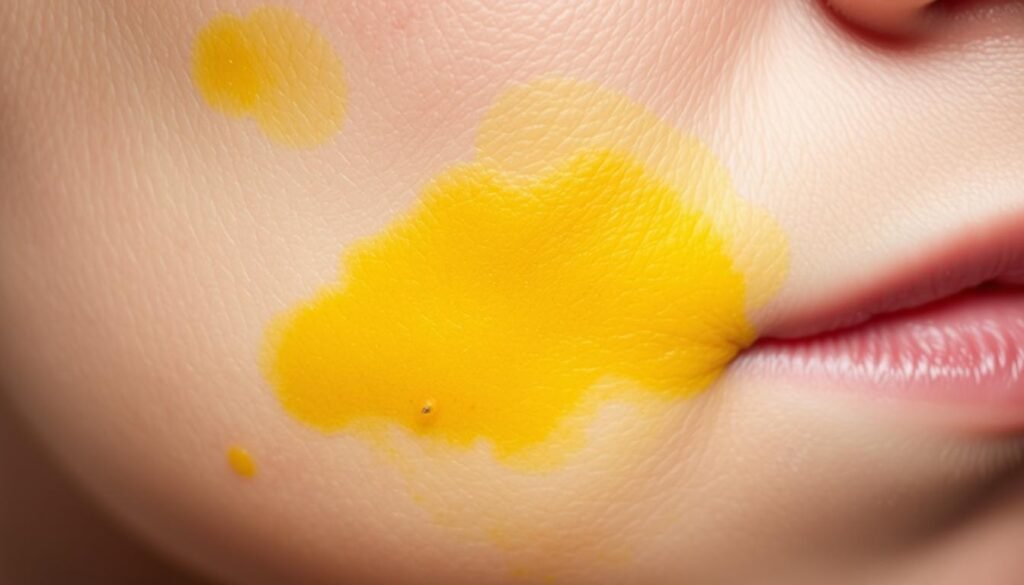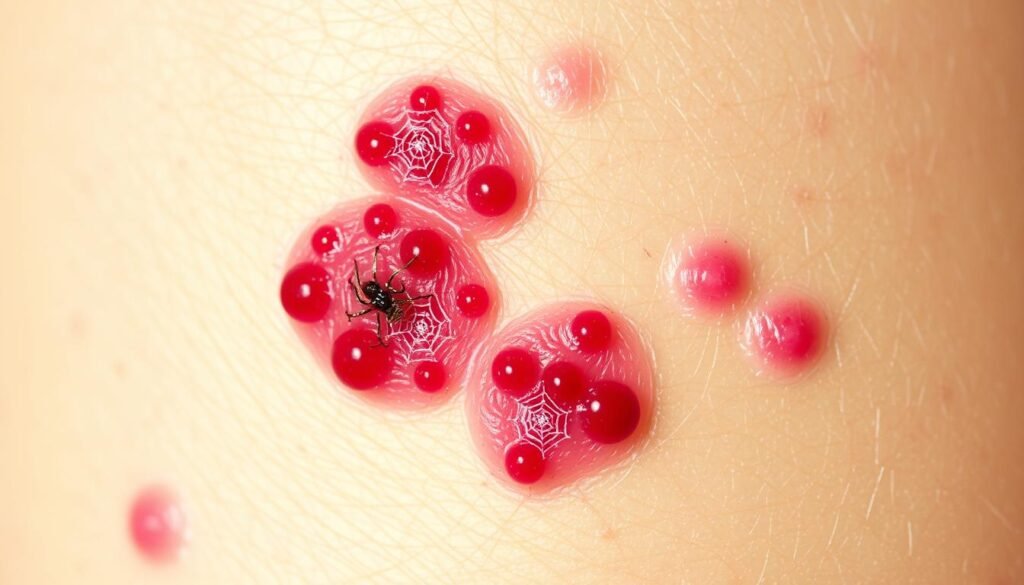Did you know about 2 million people die yearly from liver disease? The liver is the biggest inside organ, weighing up to 4 pounds. It is crucial for our health. When it’s damaged, it shows significant skin signs of liver damage. These are critical hints of liver problems. Both short-term and long-term liver disease symptoms can appear on the skin. They offer early warnings that help with quick treatment and managing the disease effectively.
It’s important to know these signs, like jaundice, spider angiomas, and palmar erythema. Recognizing skin signs of liver damage early means people can get medical advice sooner. This can stop the disease from getting worse. For more information on liver health and symptoms, check out the Cleveland Clinic’s website.

Key Takeaways
- Liver disease can lead to visible skin changes that signify health issues.
- Common signs include jaundice, spider angiomas, and palmar erythema.
- Early identification of liver disease symptoms can improve treatment outcomes.
- Maintaining a healthy lifestyle reduces the risk of liver disease.
- Seeking timely medical help for skin changes is crucial for liver health.
Understanding the Role of the Liver
The liver is the largest internal organ, weighing about three pounds. It performs essential functions crucial for our health. This important organ helps with digestion, detoxification, and cleaning our blood. It makes sure our body uses nutrients right and gets rid of toxins.
Viral infections like Hepatitis A, B, and C are major risks for liver health. Other conditions, such as autoimmune hepatitis and primary biliary cholangitis, can cause the immune system to attack the liver. Drinking too much alcohol, being overweight, and chemical exposure can also harm the liver.
To keep the liver healthy, eat well, exercise, and maintain a healthy weight. Even if the liver is hurt, it can heal itself, which is vital for fixing minor liver problems. However, long-term damage might lead to serious problems like cirrhosis. This means the liver is scarred and can’t work properly.
Jaundice makes the skin and eyes turn yellow, which is a sign of liver problems. If you have signs of liver disease, like jaundice or bad stomach pain, see a doctor right away. Every year, liver disease causes about 55,000 deaths in the U.S. It’s important to catch and deal with liver issues early.
| Aspect | Detail |
|---|---|
| Size and Weight | Largest internal organ, weighs about 3 pounds |
| Primary Functions | Digestion, detoxification, blood filtration |
| Major Diseases | Hepatitis, Autoimmune Hepatitis, Cirrhosis |
| Common Symptoms | Jaundice, abdominal pain |
| Risk Factors | Obesity, alcohol abuse, chemical exposure |
| Annual Mortality | Approximately 55,000 deaths from liver disease in the U.S. |
Common Skin Signs of Liver Damage
Your skin can show if there are some health problems, especially with the liver. There are different skin symptoms that show liver issues. Knowing these liver disease skin manifestations helps in getting medical help early.
Jaundice makes the skin and eyes turn yellow. It happens when bilirubin builds up because the liver isn’t working right. This yellowing is a clear sign that the liver may be in trouble.
Palmar erythema means your palms turn red. Around 23% of people with cirrhosis have this. Another sign is spider angiomas. These are tiny blood vessels that you can see on the skin. They often appear on the face and upper body. About 33% of people with liver issues from alcohol show these signs.
There’s also Terry’s nails. The bottom of the nail turns white with a brown to pink band on top. It happens in about 25.6% of people with cirrhosis. Muehrcke’s nails have white bands across them.
Liver disease can cause skin issues like color changes, xanthelasma (yellow patches around the eyes), and eruptive xanthomas (small yellow bumps). Almost 44% of people with cirrhosis get gynaecomastia. It shows how liver problems can change hormone levels and affect the skin.
Pruritus, or feeling very itchy, is common in 40-60% of people with cholestatic liver diseases. It’s often caused by too much bile salt in the blood. This can be very uncomfortable.
Knowing these liver disease skin manifestations is crucial. It helps you spot liver damage early. You can then get the right treatment. This knowledge could lead to better health when facing liver issues.
What is Jaundice?
Jaundice is a key symptom related to liver health. It makes the skin and eyes turn yellowish. This happens due to too much bilirubin in the blood. Bilirubin comes from the breakdown of red blood cells.
The liver processes bilirubin into bile. If this process fails, jaundice becomes visible. It signals the need for a medical check-up.
Causes of Jaundice
Many factors can cause jaundice. These range from liver diseases to bile duct blockages. It might happen due to:
- Liver diseases such as hepatitis and cirrhosis
- Bile duct obstruction from gallstones or tumors
- Increased breakdown of red blood cells
- Infections or viral illnesses affecting liver function
- Excessive alcohol consumption or fatty liver disease
- Medications that can harm the liver, such as acetaminophen when misused
A few people might have Gilbert syndrome. It slows down how the liver processes bilirubin. But it’s mild and not usually harmful.
Jaundice Observation in Skin
Lighter skin tones show jaundice more clearly. In darker skin, it’s less visible. High bilirubin can also cause itching.
Spotting jaundice signs early is crucial. It allows for quick medical help. Doctors might need to do liver tests. These help find the problem and set up the right treatment.

| Cause of Jaundice | Description |
|---|---|
| Liver Disease | Conditions like hepatitis or cirrhosis impair liver function and bilirubin processing. |
| Bile Duct Blockage | Gallstones or tumors can obstruct bile flow, leading to increased bilirubin in the blood. |
| Hemolysis | Rapid breakdown of red blood cells can overwhelm the liver’s capacity to process bilirubin. |
| Medications | Certain drugs can damage the liver, resulting in elevated bilirubin levels. |
| Alcohol Consumption | Excessive drinking can lead to liver fatty accumulation and inflammation. |
Introduction to Spider Angiomas
Spider angiomas are benign vascular lesions. They appear as small, red spots with surrounding capillaries. This gives them a “spider” look. They appear mainly on the face, neck, upper chest, and arms. Being aware of their spider angiomas symptoms is vital. It helps those keeping an eye on their liver health.

Identification and Characteristics
To identify spider angiomas, notice their unique features. They are small, with a central red spot. From this spot, small vessels spread out. Most often, these are seen in young adults as solitary spots. About 15% of them might have a spider angioma.
In patients with chronic liver disease, you might see many spider angiomas. This could signal severe liver issues with a 95% certainty.
Associated Liver Conditions
Spider angiomas often link to liver conditions like cirrhosis. Around 33% of patients with cirrhosis show these lesions. Women are more likely to have them, possibly due to high estrogen levels. Having many spider angiomas could mean a risk of worsening liver fibrosis. This calls for a deeper look into liver health and function.
Palmar Erythema: A Significant Indicator
Palmar erythema turns palms red. It suggests potential liver problems. It often comes with other skin changes in liver conditions. People with chronic liver disease usually see it more. Hormonal changes due to liver issues affect blood flow. This makes the palms and fingertips red.
How Palmar Erythema Manifests
Palmar erythema makes your palms warm and very red. This redness is a clear sign for doctors. They look for it when checking liver health. Spotting palmar erythema early helps check for diseases like cirrhosis or hepatitis. Knowing about these signs helps find the right treatment for liver problems.
This condition also warns people to get a doctor’s check-up. It shows how skin problems link to our internal health. It points to complex liver issues. Doctors use it to understand a patient’s overall health better. For more about skin and liver, check this resource on skin changes.
Understanding Pruritus in Liver Disease
Pruritus, or intense itching, is a big issue for people with liver disease. About 40-60% of these patients experience skin itching. This itching often comes from bile salts that build up in the blood, irritating the skin. It can cause discomfort all over or just in certain areas.
Liver diseases like primary biliary cirrhosis (PBC) and primary sclerosing cholangitis (PSC) often come with pruritus. In fact, up to 80% of patients with these conditions can experience this intense itching. It tends to get worse in the evening and can flare up due to heat, stress, or hormone changes during menstruation or pregnancy.
Several factors can cause skin itching in liver damage. These include high levels of histamine, changes in serotonin, and shifts in female sex hormones. A high level of serum alkaline phosphatase (ALP) is also linked to pruritus in these patients.
Treating pruritus related to liver disease usually needs several steps. Patients should try not to scratch, use mild soap, and apply creams to calm the skin. For tougher cases, doctors may prescribe medicines like cholestyramine, rifampicin, and naltrexone. Antihistamines might be used to help with sleep problems caused by the itching.
Pruritus is concerning but does not by itself show how severe the liver disease is. Still, it can lead to big problems like insomnia, fatigue, anxiety, and a lower quality of life. It’s important for patients to know pruritus can also come from other sources, not just liver disease, such as very dry skin or certain medications.
Skin Edema: What to Watch For
Skin edema is important to spot if you have liver disease. It shows up as swelling you can see. This swelling often shows up in the legs and ankles due to fluid build-up. Spotting these signs early leads to quick and effective treatment.
Causes of Edema in Liver Conditions
Several factors cause skin edema when you have liver disease. One main reason is less protein produced by the liver. This allows fluid to escape into surrounding tissues, causing swelling. Diseases like cirrhosis mess with the body’s fluid balance, leading to edema.
| Cause | Description |
|---|---|
| Reduced Protein Production | Low levels of protein, particularly albumin, contribute to fluid leaking from blood vessels. |
| Portal Hypertension | High blood pressure in the liver’s portal venous system can push fluids into surrounding tissues. |
| Kidney Dysfunction | Related conditions can lead to reduced ability to excrete sodium and water. |
| Heart Issues | Heart conditions associated with liver disease may exacerbate fluid retention. |
| Medication Effects | Certain medications can cause or worsen conditions of fluid retention. |
Keeping an eye on skin edema is crucial. If left untreated, it makes managing liver disease harder. You might notice your skin feels tighter or changes texture. Recognizing these symptoms means you can get the right help. For more info on liver disease and symptoms, check out this resource.
Bruising and Skin Changes to Notice
Spotting bruising signs is key to understanding liver health. Many people find they bruise easily and see skin changes due to liver disease. The liver helps make clotting factors. When it’s not working right, the body can’t clot as well.
This leads to more bruising and bleeding. It’s important to watch for any unusual skin changes.
Why Bruising Occurs in Liver Damage
Liver damage, like cirrhosis or hepatitis, weakens the liver’s protein-making ability. This includes proteins needed for clotting, such as fibrinogen. Also, liver issues often lower platelet counts, worsening bruising problems.
Unexplained bruising could point to serious health problems. Keeping an eye on skin changes helps catch liver damage early. For more details on liver disease symptoms and skin changes, check out this resource.